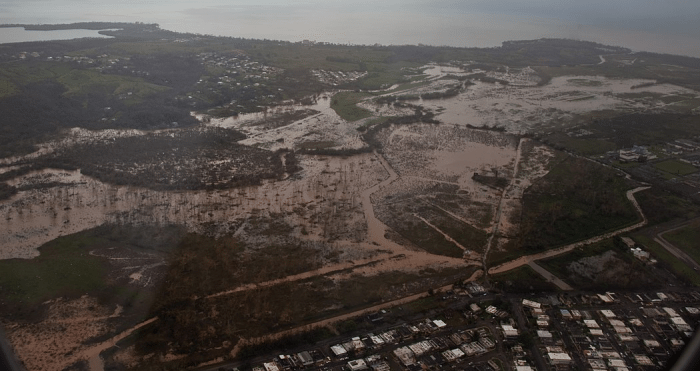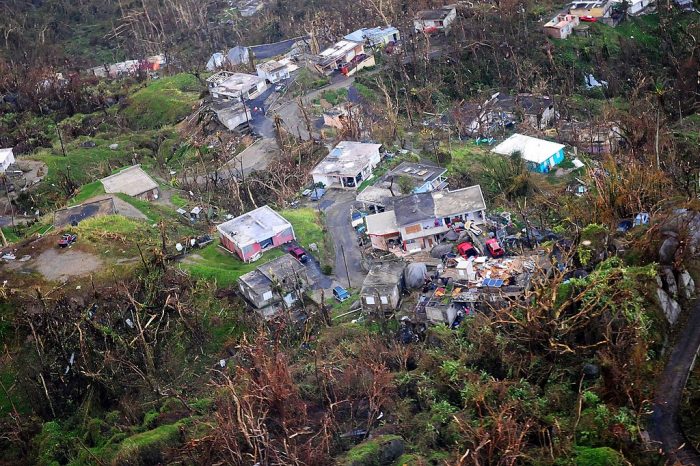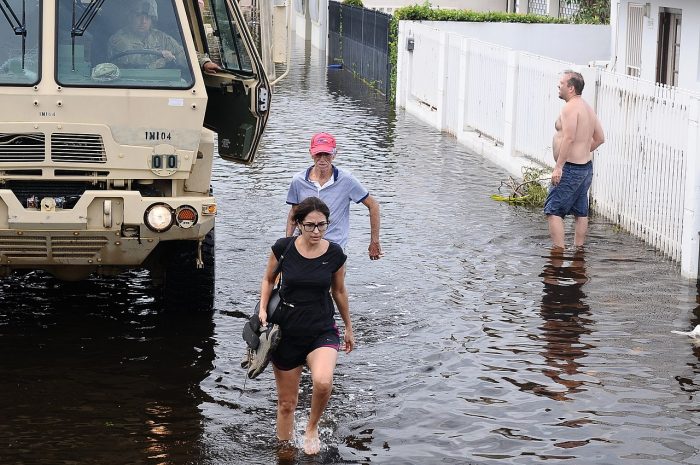One Day in the Life of a (Hurricane María) Survivor
by Ruth “Tata” Santiago, JD (lawyer) and member of the Iniciativa de Eco Desarrollo de Bahía de Jobos (IDEBAJO), a grassroots environmental group in southern Puerto Rico.
SALINAS, PUERTO RICO — My husband Roland wakes me up to the tune of “no water today.” I suspected as much when I noticed the low water pressure during my nighttime visit to the bathroom. I guess the electric generator that was powering the water pump ran out of diesel or gas or maybe it malfunctioned. It’s been on for the past two weeks and presumably they’re supposed to be used only for emergencies. Yesterday, Dr. Gerson Jiménez, the medical director at Guayama’s hospital (the only hospital still operating in the municipality of 45,000 people and serves as a regional medical facility), said he’s afraid his generators will malfunction any day now because they’re only meant to operate for 72 hours at a time.
I thought things were bad without electricity. Now without water, it seems like life will be unbearable.
The weekend weather brings more rain. It’s so hot and humid.
I wash up, using a cup of bottled water. I am using one of the few bottled waters we were able to buy at the local supermarket after, waiting hours in line a few days ago. In my “regular” life, I only use tap water after I filter it, using three different filters. But now the tap is dry. We stored water in buckets prior to the hurricane to use for the toilets. I had poured vinegar in each bucket, but now the water looks as if there are organisms growing in it.
I look through my clothes to see which pants are less dirty among the pants I’m using in this post-hurricane period. Fortunately, I have a lot of old underwear and even though some are a little small, now that I’ve lost a few pounds they fit again—I guess being forced to be on a diet is one good thing about this hurricane-harried life.
I eat oatmeal with almond milk for breakfast. I made it last night by mixing the ingredients and leaving it in a glass bowl covered overnight. We’ve discovered that almond milk doesn’t go bad from one day to the next. We stocked up on dry goods and canned food before the hurricane. I wonder what people who have more limited budgets have done. This week we heard that food rations are being handed out in long lines at the Salinas City Hall.
My plan for today is to get cash from my local co-op account because we are running very low on cash. Yesterday, we paid (a very reasonable price) to have the downed vegetation cleaned from the backyard. A few days after the hurricane, a group of neighbors opened up access to our street and removed uprooted trees. We made a seafood stew and handed them bowls and beverages in exchange for the neighborhood road cleanup. The two guys who cleaned out our backyard also started out as volunteers but now they are charging nominal fees to cut up the fallen tree trunks and branches with amazing talent and speed. Cash is needed to pay for almost everything, and the lines at banks, co-ops and other financial institutions are the longest I’ve ever seen. I noticed that the Banco Popular lines are especially long, even for their ATMs. My husband hasn’t been able to use his debit card to withdraw any funds. One of the co-ops is working fairly well, but you can only withdraw up to $300 per day. The workers helping out with the cleanup and repairs to houses and cars need to be paid in cash on a daily basis, so for many people the line to withdraw funds is a daily chore.
It’s raining fairly hard right now and the gutters look like small streams. I hope the Nigua River doesn’t flood. At the co-op earlier today, I convinced the manager to allow me to withdraw two days’ worth of funds. Walking to the car, I noticed that many of the small shops were closed. Maybe they ran out of fuel for electric generators or they didn’t have generators in the first place. Many people do not own generators because they are pricey. I think about getting a snack at a local bakery, which is open, but then I remember that they only have white bread, processed “cheese food,” ham or other cold cuts and no fruits or vegetables, so I change my mind.
On my way home, I stopped by the house of a Convivencia Ambiental (our environmental summer Camp) youth leader who told me that she has decided to leave Puerto Rico so that she can finish her last year of high school in Allentown, Pennsylvania. She decided this was her best option because she feels that even though the public schools are scheduled to reopen on October 16, the schools will be on a half-day schedule with likely no electricity because the school is currently being used as a shelter for people who lost or sustained damage to their homes. We talk about how rooftop solar units could be so beneficial at schools and other places that operate mostly during the day. Her mom asks me to draft a document ceding temporary custody to the family member that she’ll be living with in Allentown. In fact, as a community lawyer, I’ve had several high school and college students ask me for help with paperwork and information about how to transfer to academic institutions in the States. Sadly, I think to myself, Hurricane María is contributing to Puerto Rico’s on-going brain drain. Working-age people in general, and also people who require medical care, are leaving or getting ready to do so.
Since I don’t have electricity, I look daily for a spot that has a working electric generator and I sit there with my computer to prepare the paperwork for members of my community.
The fumes and noise from diesel generators are a huge problem, especially at night.
When I get home each evening, I heat up some pre-made Indian packaged food that I had stocked up on before the hurricane. I use a small gas stove that my 86-year-old mother has kept in her home for years, “in case of emergency.” I wonder what people without gas stoves are doing to eat a hot meal. I’ve heard that some people are scavenging and then burning the wood debris scattered by the storm, from houses and light poles and from who knows what, as fuel for cooking. With no water, the dirty dishes are starting to pile up. I don’t own disposable plates because I keep plastic use to a minimum, and I’m trying to keep the water in the buckets to flush the toilet. Plus, I don’t want to touch the water in the buckets because of the organisms growing in it. I think that maybe I can boil it, let it cool, and then use it to wash the dishes. But should I use the gas I have in my stove for that?
Roland is trying to figure out how to get the right front tire of his car filled or repaired. The roads are full of potholes and it is taking a toll on the tires and possibly on the car parts. He heads out to find a garage with an air compressor and then heads to work. He is only working in the afternoons because Guayama’s courthouse was badly damaged. He and his colleagues are discussing the new logistics of handling felony cases in the small courthouse in Salinas. Half jokingly they pose the idea that perhaps they should interview their clients in their cars.
My sister, who works at a large pharmaceutical company, has not been able to work at the plant because of serious damage to the structure and the lack of electric power. She purchased a large electric generator for her home that she’ll be installing as soon as she can locate an electrician and otherwise work out the logistics.
As I walk to my car, I see that my sister is in the process of bringing plastic buckets outside to collect rain-water for flushing her toilet. I tell my sister, “Bye, I got to run to an IDEBAJO meeting.”
Life in the Aftermath of Hurricane María
Contributors: Ruth “Tata” Santiago, Hilda Lloréns, Carlos Garcia-Quijano, and Catalina de Onís
About 85 percent of Puerto Rico remains without electric power, and full restoration is not expected for months. We applaud the urgent organizing efforts of Casa Pueblo and others to generate and distribute much-needed solar energy in the regions of Adjuntas, Utuado, and Jayuya. However, other areas, such as frontline communities in Salinas in the island’s southern region, have not been reached by the various aid efforts. This must change.
Tata Santiago, a long-time member of the Iniciativa de Eco Desarrollo de Bahía de Jobos (IDEBAJO), who survived Hurricane María and who lives in Puerto Rico, shared the following information with Hilda Lloréns, who summarized the conversation with diaspora-IDEBAJO supporters in an October 6 email:
Right now, we (Ruth “Tata” Santiago and IDEBAJO) are trying to set up a command center in Salinas to get solar-powered lamps to folks and to hook up the El Coquí’s community center’s refrigerators to solar generators to store medicine and ice (ice is hard to find right now). Salinas and the southern part of PR has not received any aid as of today. The American Red Cross came to Salinas yesterday and set up a satellite antenna in the main square (plaza) for a few hours so that residents could make phone calls. AT&T and Claro have also been setting up antennas for a few hours each evening in Guayama’s convention center. FEMA also went to the plaza to hand out forms for folks to make claims. People are living in dire conditions. When the night falls (and in PR night falls at 6pm this time of year), people are completely in the dark. Batteries (AA, AAA, etc.) are running out at the stores; there is no ice; people are having a hard time keeping medicine cool; people are living in parts of their houses that were not blown away by the storm; and gas is hard to come by. People are having a hard time just getting around, and those who have generators are hardly keeping the generators running because of lack of access to diesel.
Members and supporters of IDEBAJO are in the process of sending two solar-powered generators, small solar lamps, batteries, and wi-fi satellite devices to Salinas. For the past few days, we have been struggling to find ways to send these supplies to Salinas. (Costco doesn’t have generators, and Home Depot and Lowe’s do not deliver to Puerto Rico, while Amazon only delivers certain items.) These are essential resources for frontline communities grappling with the energy colonialism, which has been aggravated by Hurricanes Irma and María. The suffering and devastation that is happening NOT caused just by “natural” disasters. The frequency and severity of the extreme weather events that hit the Caribbean, Gulf Coast, and other areas this hurricane season are likely linked to anthropogenic global climate disruption, which burdens with disproportionate effects those communities that are ill-equipped to “bounce back,” as resilience discourses would have it. These communities contribute very little to CO>2 emissions but are bearing the brunt of the consequences fueled by our carbon-based economy.
To contextualize the precarious situation communities in Salinas and throughout the southeast find themselves in, we must be cognizant that this region has been known in Puerto Rico as the “hunger route.” In Salinas, 60.6% of the population lives in poverty with a median household income of $15, 510. According to the 2010 U.S. Census, 17 percent of people in the region self-identified as black, a percentage well above the 12.4 national average. The low-income communities in the Jobos Bay, located between Salinas and Guayama, have long suffered from the pollution generated by two electricity-generating power plants as well as other industries located in their communities. These communities consume less of the energy that is produced in their backyards because they can’t afford the electricity bills, and yet they pay a high price with their health and the health of their environments. They are the most affected, and as we are witnessing in the aftermath of hurricane María, the last to receive aid when they need it most.
Because these are frontline communities, they have been at the forefront of resisting injustice and devising solutions to the environmental problems that affect them. For instance, South Against Pollution, Comité Diálogo Ambiental, and IDEBAJO were at the forefront of the fight against the government-private industry plan to build a 700-million dollar AES coal-power plant on a wetland adjacent to the Jobos Bay dating back to 1998. Similarly, Comité Diálogo Ambiental has been at the forefront of the fight against the irresponsible handling and disposal of the toxic coal-ash produced at AES, as well as trying to stop the Aguirre Offshore Gasport Project, a subsea liquefied natural gas (LNG) pipeline proposed in the Jobos Bay. The group has legally challenged smaller-scale threats to the health of coastal environments, such as mangrove forests deforestation for urban development. Looking for solutions and alternatives to dirty energy, IDEBAJO has been trying to bring the solar project Coquí Solar to fruition for nearly a decade. They work with precious few resources and rely on volunteer work in their struggle to safeguard their environment and to provide a healthier life for current and future generations.
While offers by Elon Musk to reimagine Puerto Rico’s energy system with solar and batteries to power the entire island might be appealing for some, frontline communities must play a central role in the transformation of Puerto Rico’s energy system, rather than relying on outsiders who stand to profit from disaster capitalism and green capitalism in these trying times. To transition otherwise only will perpetuate past exploitation. Thus, it is crucial that communities most affected receive the support for which they are asking to advance their own community-controlled self-determination. At the moment, they have determined that the most pressing need involves establishing a solar-powered community-level energy grid that can enable them to self-organize without depending completely on central government recovery efforts.
If you’d like to donate to IDEBAJO’s solar energy fundraiser, please contribute here. Also, consider mailing small solar lamps, batteries, and Wi-Fi satellite devices. The Salinas post office is now open.






[…] on the plan and an organizer with the Jobos Bay Eco-Development Initiative, which is developing a community solar system in the […]
[…] on the plan and an organizer with the Jobos Bay Eco-Development Initiative, which is developing a community solar system in the […]
[…] on the plan and an organizer with the Jobos Bay Eco-Development Initiative, which is developing a community solar system in the […]
[…] collaborator on the plan and an organizer with the Jobos Bay Eco-Development Initiative, which is developing a community solar system in the […]
[…] on the plan and an organizer with the Jobos Bay Eco-Development Initiative, which is developing a community solar system in the […]
[…] on the plan and an organizer with the Jobos Bay Eco-Development Initiative, which is developing a community solar system in the […]
[…] YORK (AP) — Five years after Hurricane María slammed into Puerto Rico and exposed the funding problems the Caribbean island has long faced, philanthropists warn that […]